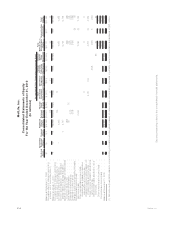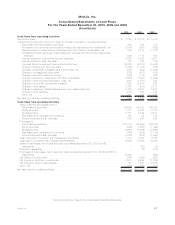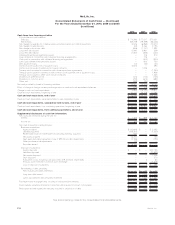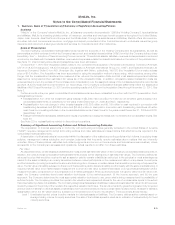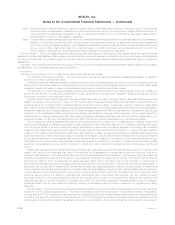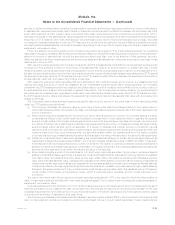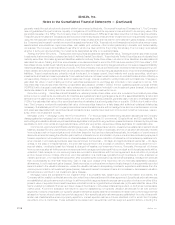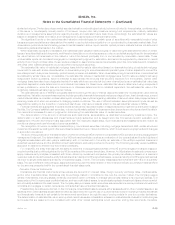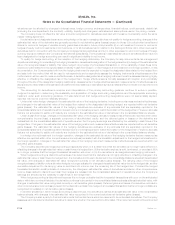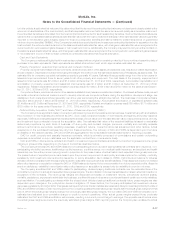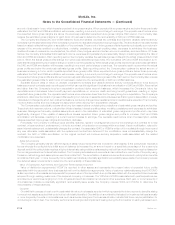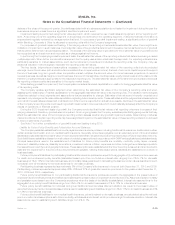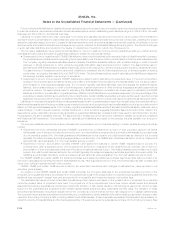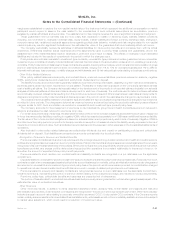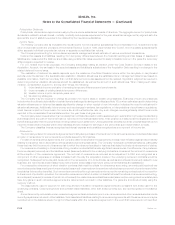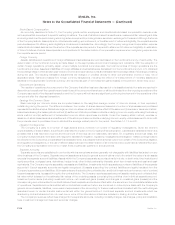MetLife 2010 Annual Report Download - page 103
Download and view the complete annual report
Please find page 103 of the 2010 MetLife annual report below. You can navigate through the pages in the report by either clicking on the pages listed below, or by using the keyword search tool below to find specific information within the annual report.periodically reviews its properties held-for-investment for impairment and tests properties for recoverability whenever events or
changes in circumstances indicate the carrying amount of the asset may not be recoverable and the carrying value of the property
exceeds its estimated fair value. Properties whose carrying values are greater than their undiscounted cash flows are written down to
their estimated fair value, with the impairment loss included in net investment gains (losses). Impairment losses are based upon the
estimated fair value of real estate, which is generally computed using the present value of expected future cash flows from the real
estate discounted at a rate commensurate with the underlying risks. Real estate acquired upon foreclosure is recorded at the lower of
estimated fair value or the carrying value of the mortgage loan at the date of foreclosure.
Real Estate Joint Ventures and Other Limited Partnership Interests. The Company uses the equity method of accounting for
investments in real estate joint ventures and other limited partnership interests consisting of leveraged buy-out funds, hedge funds and
other private equity funds in which it has more than a minor equity interest or more than a minor influence over the joint ventures or
partnership’s operations, but does not have a controlling interest and is not the primary beneficiary. The equity method is also used for
such investments in which the Company has more than a minor influence or more than a 20% interest. Generally, the Company records
its share of earnings using a three-month lag methodology for instances where the timely financial information is available and the
contractual right exists to receive such financial information on a timely basis. The Company uses the cost method of accounting for
investments in real estate joint ventures and other limited partnership interests in which it has a minor equity investment and virtually no
influence over the joint ventures or the partnership’s operations. The Company reports the distributions from real estate joint ventures
and other limited partnership interests accounted for under the cost method and equity in earnings from real estate joint ventures and
other limited partnership interests accounted for under the equity method in net investment income. In addition to the investees
performing regular evaluations for the impairment of underlying investments, the Company routinely evaluates its investments in real
estate joint ventures and other limited partnerships for impairments. The Company considers its cost method investments for OTTI
when the carrying value of real estate joint ventures and other limited partnership interests exceeds the net asset value (“NAV”). The
Company takes into consideration the severity and duration of this excess when deciding if the cost method investment is
other-than-temporarily impaired. For equity method investees, the Company considers financial and other information provided by
the investee, other known information and inherent risks in the underlying investments, as well as future capital commitments, in
determining whether an impairment has occurred. When an OTTI is deemed to have occurred, the Company records a realized capital
loss within net investment gains (losses) to record the investment at its estimated fair value.
Short-term Investments. Short-term investments include investments with remaining maturities of one year or less, but greater
than three months, at the time of purchase and are stated at amortized cost, which approximates estimated fair value, or stated at
estimated fair value, if available.
Other Invested Assets. Other invested assets consist principally of freestanding derivatives with positive estimated fair values,
leveraged leases, investments in insurance enterprise joint ventures, tax credit partnerships, funding agreements, mortgage servicing
rights (“MSRs”) and funds withheld.
Freestanding derivatives with positive estimated fair values are described in the derivatives accounting policy which follows.
Leveraged leases are recorded net of non-recourse debt. The Company participates in lease transactions which are diversified by
industry, asset type and geographic area. The Company recognizes income on the leveraged leases by applying the leveraged lease’s
estimated rate of return to the net investment in the lease. The Company regularly reviews residual values and impairs them to expected
values.
Joint venture investments represent the Company’s investments in entities that engage in insurance underwriting activities and are
accounted for under the equity method.
Tax credit partnerships are established for the purpose of investing in low-income housing and other social causes, where the
primary return on investment is in the form of tax credits and are also accounted for under the equity method or under the effective yield
method. The Company reports the equity in earnings of joint venture investments and tax credit partnerships in net investment income.
Funding agreements represent arrangements where the Company has long-term interest bearing amounts on deposit with third
parties and are generally stated at amortized cost.
MSRs are measured at estimated fair value and are either acquired or are generated from the sale of originated residential mortgage
loans where the servicing rights are retained by the Company. Changes in estimated fair value of MSRs are reported in other revenues
in the period in which the change occurs.
Funds withheld represent amounts contractually withheld by ceding companies in accordance with reinsurance agreements. The
Company records a funds withheld receivable rather than the underlying investments. The Company recognizes interest on funds
withheld at rates defined by the terms of the agreement which may be contractually specified or directly related to the underlying
investments and records it in net investment income.
Investments Risks and Uncertainties. The Company’s investments are exposed to four primary sources of risk: credit, interest rate,
liquidity risk, and market valuation. The financial statement risks, stemming from such investment risks, are those associated with the
determination of estimated fair values, the diminished ability to sell certain investments in times of strained market conditions, the recognition
of impairments, the recognition of income on certain investments and the potential consolidation of VIEs. The use of different methodologies,
assumptions and inputs relating to these financial statement risks may have a material effect on the amounts presented within the
consolidated financial statements.
When available, the estimated fair value of the Company’s fixed maturity and equity securities are based on quoted prices in active markets
that are readily and regularly obtainable. Generally, these are the most liquid of the Company’s securities holdings and valuation of these
securities does not involve management judgment.
When quoted prices in active markets are not available, the determination of estimated fair value is based on market standard valuation
methodologies. The market standard valuation methodologies utilized include: discounted cash flow methodologies, matrix pricing or other
F-14 MetLife, Inc.
MetLife, Inc.
Notes to the Consolidated Financial Statements — (Continued)


